Reaper on Wayland
Digging into WDL and GDK
Reaper on Wayland
Context
Wayland is a display communication protocol on Linux, and it has been getting ever so popular lately. There's still quite a lot of software lacking native support for it. One of these is Reaper. It's what I use for music production.
In addition to the many things Reaper does well, turns out that the API it uses for UI rendering on Linux is open-source. It's available here inside the WDL repository. And that's very convenient for the purposes of this post.
WDL contains a lot of features, but we're mostly interested in SWELL. It acts as a bridge between win32 API, allowing Reaper to run on Linux and Mac.
What happens under the hood in SWELL is that it uses GDK for displaying all the various UI windows, along with Cairo for rendering.
But why doesn't it run on Wayland then? Let's find out.
Getting started
First, let's replace the libSwell library used by our existing Reaper installation. Start by building SWELL with make:
cd WDL/WDL/swell
make DEBUG=1After this, you have a libSwell.so library file in the current directory. Let's symlink it to Reaper so that is uses the newly built one instead of the default library it ships with:
cd <path_to_reaper>
mv libSwell.so libsSwell.so.bak
ln -s <path_to_WDL_repo>/WDL/swell/libSwell.so libSwell.soNext, ensure you have a desktop environment running on Wayland. For reference, I'm running Sway from a terminal on i3, my current window manager for X. This makes prototyping Wayland work relatively easy without having to log on/off all the time.
First launch
Sidenote: to quickly get the process ID of Reaper for debugging, you can run this:
ps aux | grep "./reaper" | grep -v "grep" | awk '{print $2}' | xclip -selection clipboardLet's start by launching Reaper with:
cd <path_to_reaper>
GDK_BACKEND=wayland ./reaper
Segmentation fault: 11 (core dumped)
Aaaaand we crashed. But that's expected.
There's a lot of behavior on SWELL which uses native X11 functions, such as getting the name of the current window manager. As the whole concept of a window manager is not valid on Wayland, we'll need to start branching things out.
For instance, if I want to only include code while targeting Wayland, I use #ifdef GDK_WINDOWING_WAYLAND
For instance, when focus is deactivated, the desktop name is queried here:
static void on_deactivate()
{
swell_app_is_inactive=true;
HWND lf = swell_oswindow_to_hwnd(SWELL_focused_oswindow);
#ifdef GDK_WINDOWING_X11
if (GDK_IS_X11_WINDOW (lf->m_oswindow))
s_last_desktop = lf && lf->m_oswindow ? _gdk_x11_window_get_desktop(lf->m_oswindow)+1 : 0;
#endif
#ifdef GDK_WINDOWING_WAYLAND
if (GDK_IS_WAYLAND_WINDOW (lf->m_oswindow))
s_last_desktop = lf && lf->m_oswindow ? 0+1 : 0;
#endif_gdk_x11_window_get_desktop is X11-specific, so that won't work.
This feature isn't critical for now, so let's move on.
Or this one, here we're looking at the window manager name. The whole concept of a window manager doesn't exist on Wayland, but the closest thing is the compositor. In my case Sway. Sure, the might be a programmatic way of querying it but for now I'll just hard-code it:
if (GDK_IS_X11_DISPLAY (gdkdisp))
wmname = gdk_x11_screen_get_window_manager_name(gdk_screen_get_default());
else
wmname = "sway";After quite a few of these changes, we finally get Reaper to start up:
A quick sanity check the list of current windows on sway and ensure Reaper is there:
swaymsg -t get_treeThis gives us
#1: root "root"
#3: output "X11-1"
#9: workspace "1:web"
#18: con "(null)"
#28: con "(null)"
#39: con "(null)"
#42: con "(null)"
#37: con "REAPER v6.82 <==BINGOAlternatively, run xprop and hover the cursor on top of the Reaper's main window.
If running on X11 through xwayland, you would get a crosshair with xprop:
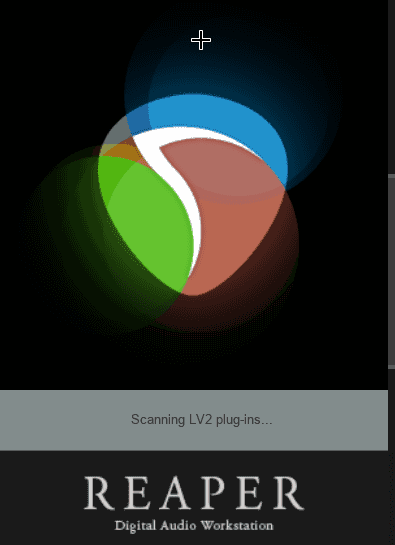
Whereas now on Wayland we get this:
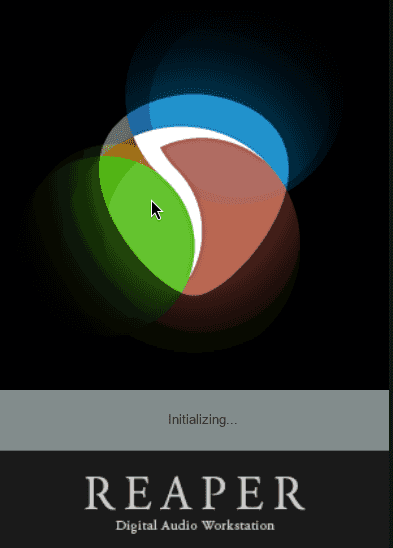
In either case, we can see that Reaper is now running on Wayland.
Screen updates are broken
Now we start to get to the interesting bits. While browsing the UI, not a whole lot of the screen seems to update. I can see the track layout and the playhead view, but scrolling does mostly nothing.
Here's the starting point when having 10 or so tracks:
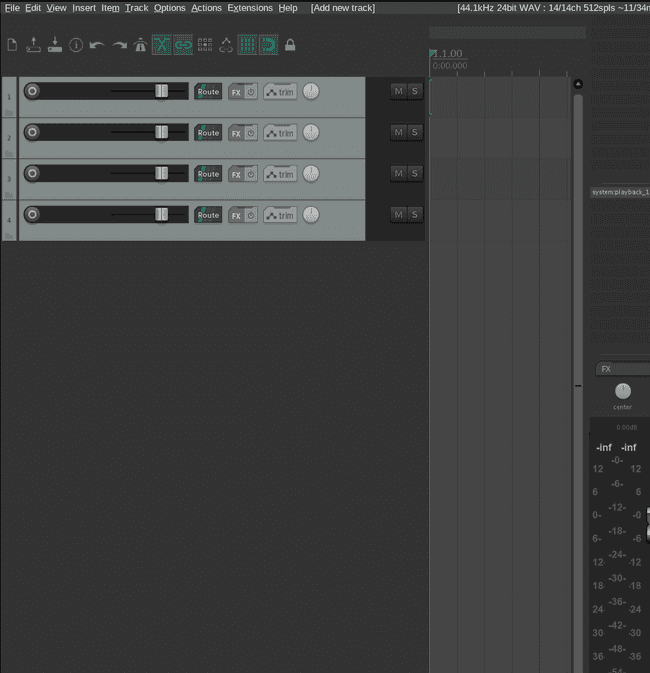
And here's the screen when it's scrolled to the bottom:
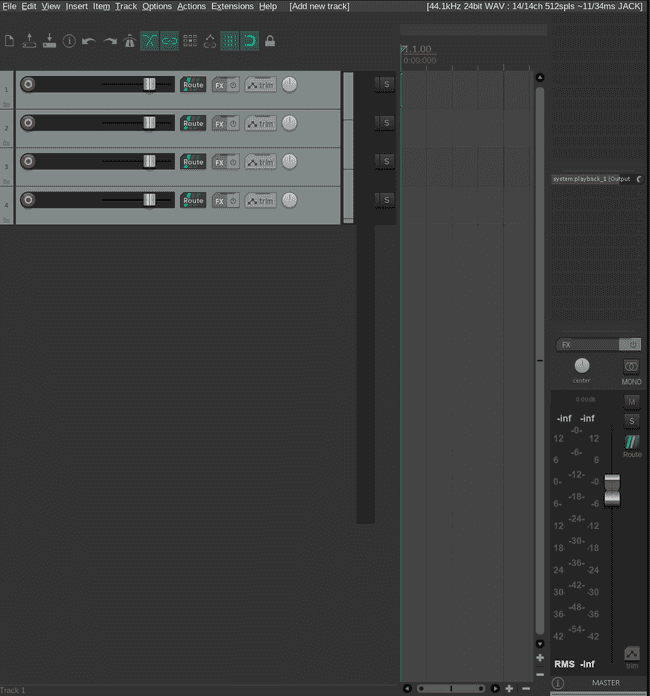
So normally the track height should be increased, but right now it's not updating. The black bar on the right of the tracks extends to the bottom like it should.
After moving the cursor from Reaper to a another window on the desktop and back, suddenly the UI is rendered properly.
How does it render?
First we'll need to find what actually draws the updates to the screen.
Since I'm on Linux, SWELL uses GDK and Cairo for drawing on the screen, and the functions are found in the file swell-gdk-generic.cpp
In swell-gdk-generic.cpp, there's two main points of calling Cairo's rendering functions, swell_oswindow_updatetoscreen and OnExposeEvent. OnExposeEvent is just an event handler for GDKs own ExposeEvent, which occurs when GDK thinks an area needs to be redrawn on the UI.
This means various hover events, like hovering over a button or some resize handle. Resizing any element also triggers this.
The swell_oswindow_updatetoscreen() (I'll refer to it as just updatetoscreen) function on the other hand renders elements out of GDK's event loop, when the ReleaseDC call (from Win32 API) is made in swell-gdi-lice.cpp
This is what updates the volume meters:
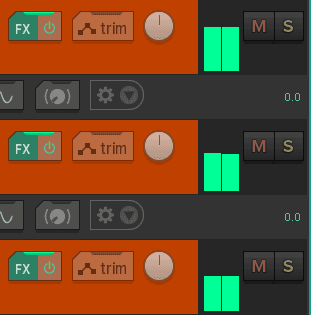
And the main playhead (the yellow vertical line which moves from left to right when you press play):

The volume meters and main playhead have to update much more frequently than any event would arrive. Even when the user just is listening, you still need to update the playback position and the volume of individual tracks. So drawing outside of the event loop s completely understandable.
But drawing outside the event loop now keeps messing up everything on Wayland.
Debugging the screen updates
After commenting out everything in the updatetoscreen function, now the UI starts rendering somewhat properly. Hover effects work and elements resized correctly.
But now none of the db meters, neither the playhead update when playback is started. Well that's due to removing the rendering of those parts.
But why did this happen? Think about a single expose event. You hover over one element once, the UI renders that element and that's it.
Now think about the volume meters and the playhead. Those are updating all the time.
Since the updatetoscreen is called more frequently, chances are that immediately after an expose event it's time to render the db meters and the playhead.
void swell_oswindow_updatetoscreen(HWND hwnd, RECT *rect)The area updated is supposed to be restricted on just a small subset of the whole screen. That's the purpose of the GDK rectangle specified there.
Well what happens if we just override this? Let's take the measurements of the window like this:
RECT cr;
cr.left=cr.top=0;
cr.right = hwnd->m_position.right - hwnd->m_position.left;
cr.bottom = hwnd->m_position.bottom - hwnd->m_position.top;And use them to force GDK to render the whole area.
rect = &cr;
cairo_rectangle_int_t cairo_rect={rect->left,rect->top,rect->right-rect->left,rect->bottom-rect->top};
const cairo_region_t* rrr = cairo_region_create_rectangle(&cairo_rect);
GdkDrawingContext* context = gdk_window_begin_draw_frame(hwnd->m_oswindow, rrr);Now the oswindow updates are not disturbing the hover events anymore.
All the volume meters now update, and scrolling works somewhat.
From no updates to infrequent updates
When pressing play, the playhead updates maybe once, and then nothing. The playback continues, scroll and hover events work just fine. But not the playback and volume meters.
So how to debug this?
Maybe color the rendered areas differently inside the updatetoscreen function?
Yeah, let's add that.
#ifdef RAND_COLOR_OVERLAY
auto r1 = ((double) rand() / (RAND_MAX));
auto r2 = ((double) rand() / (RAND_MAX));
auto r3 = ((double) rand() / (RAND_MAX));
cairo_set_source_rgba(crc, r1, r2, r3, 0.5);
cairo_rectangle(crc, cairo_rect.x, cairo_rect.y, cairo_rect.width, cairo_rect.height);
cairo_clip(crc);
cairo_fill(crc);
cairo_paint_with_alpha(crc, 0.1);
#endif //RAND_COLOR_OVERLAYSimply put, this code takes 3 random values, one for red, one for blue and one for green. These are then forwarded to Cairo, which allows us to overlay the region with a random color.
Lastly, we paint the whole surface with 10% transparency. (Should've seen my face when I painted the surface without any alpha, there wasn't anything to debug anymore.)
Now when SWELL is compiled with the RAND_COLOR_OVERLAY you'll get to see some flickering lights whenever updatetoscreen is called.
Let's take a look at this on Wayland.
- Start the playback
- The audio playhead starts moving, but occasionally it freezes
- This is due to the
updatetoscreenfunction not being called
- Resize the first audio track
- This calls a separate function intended for resizing
- Here the whole screen is set to be refreshed
- And as such you get the playhead moving
But how does it look on X11? Like the following:
NOTE: This video contains rapidly flickering lights!
You can see how the playback area flashes constantly now that the refresh events are sent correctly, even if I'm not moving my mouse.
Thoughts on the rendering
Funnily enough, the rendering done in OnExposeEvent is very similar to rendering done in updatetoscreen. So what gives? Is there something on Wayland that prevents the updatetoscreen function from being called?
Let's add some good old printf debugging and see how much spam we get in terminal.
Okay, a lot. The updatetoscreen function is called as expected (very frequently). So something has to prevent the contents from ending up on the screen?
I already overrode the rectangle to be my whole screen. And it's not like the rendering breaks on X11, you saw from the previous video that it worked as expected.
Maybe let's dig down deeper to what are the actual differences between OnExposeEvent and updatetoscreen rendering? Maybe there would be something extra necessary to be done on Wayland to refresh the screen.
Well, not a whole lot. But instead of drawing peculiarities, what about the contents being drawn? If you keep rendering the same contents over and over again, it doesn't matter how frequently your function is called.
No colors for me
But also, there shouldn't be any static colors on the playhead area, since assuming that updatetoscreen is called constantly.
So if there's a lot of calls to updatetoscreen, there should also be new random color combinations being drawn as well.
But if the color never changes, it's not like the bitmap contents are stuck internally. If this was the case, the playhead view would appear frozen but the color would keep flickering. So the same image would be displayed but just with a different color overlay each time.
Since this is not the case it has to be in how the Cairo drawing context is handled in the OnExposeEvent function and in updatetoscreen.
Well just for fun, let's comment out the Cairo rendering calls from OnExposeEvent. Now we won't get any updates on mouse hovers etc. but we should still get the main playback view.
On Wayland, nothing.
But what about X11? Yes, the playback view still shows up.
So the issue is that the Cairo overlays go through somewhat, but they don't actually end up on the screen by the updatetoscreen.
Instead, they "wait" for the update to the next ExposeEvent to happen, after which the view which was rendered the last time shows up on the screen.
And that's why the flickering does not happen.
But what about the prints from the color overlay? They are still called on Wayland. So there is something being colored, but it just never shows up.
So what if there's a difference between X11 and Wayland on how the screen is updated?
Here's a snippet when running with WAYLAND_DEBUG=1:
[1394811.284] {Default Queue} -> wl_surface#41.attach(wl_buffer#38, 0, 0)
[1394811.304] {Default Queue} -> wl_surface#41.set_buffer_scale(1)
[1394811.309] {Default Queue} -> wl_surface#41.damage(0, 0, 2528, 1378)
[1394811.317] {Default Queue} -> xdg_toplevel#44.set_min_size(300, 300)
[1394811.322] {Default Queue} -> xdg_toplevel#44.set_max_size(16384, 16384)
[1394811.328] {Default Queue} -> xdg_surface#43.set_window_geometry(0, 0, 2528, 1378)In short, what happens in the logs is the following:
- Attach to the surface (the Reaper main window we're about to draw to)
- Set a scale for the buffer we're drawing
- Damage the surface
- This indicates to the compositor that the surface needs to be redrawn
However, there's no reference to a commit call here. So even though we tell Wayland that the full window needs to be redrawn, we never commit the call and apply it in action.
To force SWELL to commit the changes on Wayland, we can invalidate the are we're drawing.
SWELL already has a function swell_oswindow_invalidate which under the hood calls gdk_window_invalidate_rect. This should do the trick.
void swell_oswindow_invalidate(HWND hwnd, const RECT *r)
{
GdkRectangle gdkr;
if (r)
{
gdkr.x = r->left;
gdkr.y = r->top;
gdkr.width = r->right-r->left;
gdkr.height = r->bottom-r->top;
}
gdk_window_invalidate_rect(hwnd->m_oswindow,r ? &gdkr : NULL,true);
}So the solution here is to call
void swell_oswindow_updatetoscreen(HWND hwnd, RECT *rect)
----many lines omitted----
gdk_window_end_draw_frame(hwnd->m_oswindow, context);
if (temp_surface) bm->Extended(0xca140,temp_surface); // release
swell_oswindow_invalidate(hwnd, rect);
gdk_window_process_updates(hwnd->m_oswindow, true);
}
#endif
}Now the playback view starts renderng correctly. There's no expose events being sent and it still updates constantly on Wayland.
In the debug logs we can now see the wl_commit happening after the surface has been damaged:
[1745078.804] {Default Queue} -> wl_surface#44.attach(wl_buffer#42, 0, 0)
[1745078.824] {Default Queue} -> wl_surface#44.set_buffer_scale(1)
[1745078.827] {Default Queue} -> wl_surface#44.damage(0, 0, 1261, 1354)
[1745078.832] {Default Queue} -> xdg_toplevel#36.set_min_size(300, 300)
[1745078.837] {Default Queue} -> xdg_toplevel#36.set_max_size(16384, 16384)
[1745078.843] {Default Queue} -> xdg_surface#47.set_window_geometry(0, 0, 1261, 1354)
[1745078.870] {Default Queue} -> wl_buffer#41.destroy()
[1745078.875] {Default Queue} -> wl_shm_pool#43.destroy()
[1745079.155] {Default Queue} -> wl_surface#44.frame(new id wl_callback#46)
[1745079.162] {Default Queue} -> wl_surface#44.commit()Interestinly after this, no flicker happens at all on Wayland. So the solution is not quite perfect, as the color overlay I added for debugging does not work.
But since the playhead now moves as expected, I'm going to let it pass. Let's move on to the next issue.
Fixing mouse event offsets
After fixing the playhead view updates, there's still more issues on the screen updates.
All of the mouse hover elements aren't doing anything. For instance, when you hover your cursor over the M (mute) or S (solo) buttons, they're supposed to change to a slightly lighter color.
In addition, when hovering the mouse over Reaper's track control panel I get this:
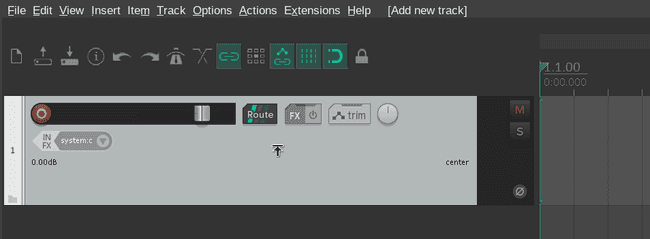
The mouse is supposed to change it's indicator to a resize cursor at the bottom of that light grey are. And certainly not in the middle. Looks like we've got some very odd mouse offset going on.
Oh well, let's add some more prints. Here m is the mouse event as delivered by GDK.
POINT p2={(int)m->x_root, (int)m->y_root+Y_COORD_OFFSET};
printf("p2 x: %u y:p2.%u \n", p2.x, p2.y );This results in the following:
p2 x: 6406 y:p2.1715
p2 x: 6406 y:p2.1778
p2 x: 6406 y:p2.1846
p2 x: 6406 y:p2.1907
p2 x: 6406 y:p2.1967
p2 x: 6406 y:p2.2027
p2 x: 6406 y:p2.2073 Hold on, what? My desktop's resolution is 3840x2160, so the x coordinate is going off the charts.
That p2 is coming from the GDK event x_root and y_root, interesting.
So since the coordinates are already weird coming from GDK, it's likely an environment issue and not me poking around SWELL's code.
Wait. Just to make sure, maybe I have something wrong in my environment? That 6000px x coordinate would indicate that. Well, my X screen does have that size due to two monitors, but I run Sway in a single window. I think I have some scaling on, 1.25x for GDK and QT apps. Not really related to Reaper, but Sway has this:
output DP-1 scale 1.2 But since X11 doesn't have any scaling, I've configured Reaper separately to use 1.3x scaling:
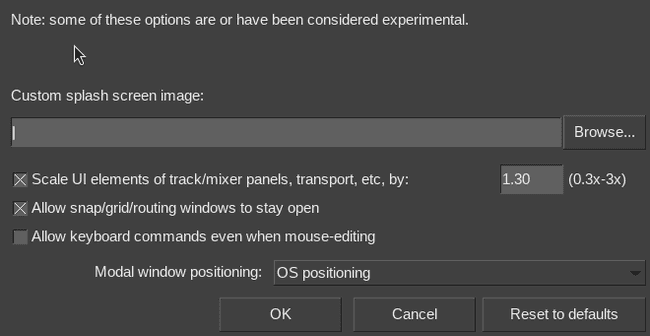
So there's many points at which the scaling can go wrong:
- Reaper built-in scaling
- GDK build-in scaling
Maybe that could be it? 6400/3840 is ~ 1.67. The combined scale of 1.2 x 1.3 is 1.56, so we're not quite there yet.
1.2 * 1.3 * 3840 = 5990.4
Luckily I have a second monitor. So move sway there and start reaper, let's try again.
Oh. Now it works.
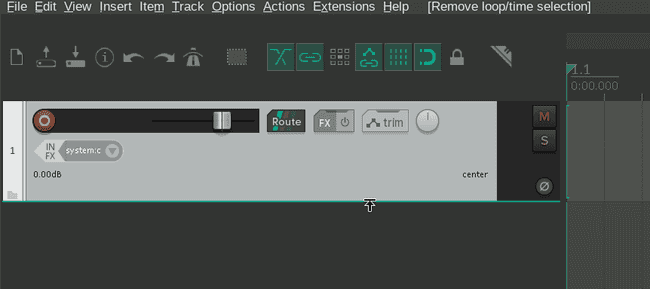
And what if I the whole sway window back to my main display?
Still working.
And what if I restart reaper while sway is running on the main display (DP-1)?
Broken again.
So Sway does handle the scaling somewhat automatically. But the problem is that since X11 (and win32 API for that matter) does not support scaling, there's all kinds of tricks done in SWELL to get it working.
So the solution is to start Reaper on a display without scaling and then move the window to the window with scaling. Got it.
Let's open Sway separately instead of inside X11 so that we get a proper look on this. Ah, here the UI elements are much larger than before.
So GDK does some of its own scaling in addition to SWELL's scaling.
I have output DP-1 scale 1.2 in my Sway config.
To make matters even more complicated, I also have Xft.dpi: 120 in my .Xresources.
And if that isn't still enough, this random offset seems to change constantly.
After a while of development, I'm greeted with the x-axis being offset by 857 pixels. And this time it doesn't matter if I move the sway window to a nother display. Neither does it make any difference if I launch sway as a separate session, the x-axis offset still persists.
This seems to be some GDK oddity. Even though the window placement changes, the x_root and y_root never change. So GDK thinks the parent window never moves, and as such the root coordinates are incorrect.
But then again, some day after restarting Reaper (without doing a clean build!) GDK just happens to set the offset correctly.
What a bug. On the bright side, you'll be fine if you don't use scaling.
Popups opening in incorrect places
Right now all popups and dialogs open at incorrectly on Wayland. Instead of appearing right where the mouse is, they are shown in the middle of the screen:

Maybe this has something to do with all the excluded X11-related functions?
Or maybe it's not GDK-related at all? Let's start by looking at some windowing-related code.
In swell-wnd-generic.cpp, there's SetWindowPos(), which in turn calls swell_oswindow_resize() when the window needs to be resized. And that's pretty much every time a new window is updated to the screen.
Inside oswindow_resize() there's a reposflag. Let's add some good 'ol printf debugging so we'll and experiment a bit on how new windows are shown in SWELL.
Inside swell_oswindow_resize() the GDK functions gdk_window_move_resize() and gdk_window_move() are called.
if ((reposflag&3)==3) gdk_window_move_resize(wnd,f.left,f.top,f.right-f.left,f.bottom-f.top);Trouble is that the values here look correct, the coordinates at which the popup menu should be displayed are the same as the last mouse coordinates
A quick look in debugger gives me this:
*- f: {...}
- left: 390
- top: 245
- right: 817
- bottom: 989And these were the last few mouse positions:
p1 x: 395 p1 y: 228
p2 x: 400 p2 y: 263
p1 x: 385 p1 y: 211
p2 x: 390 p2 y: 246 So the newly created popup or dialog should get placed right were the mouse is.
But it goes to the center of the screen.
Wait a moment, is this another environment issue? Maybe it's just Sway centering all floating dialogs?
Just to verify, let's try the same on Gnome:
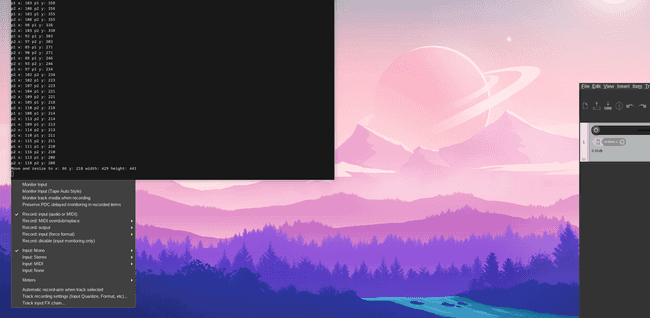
Nope. Still all over the place. Shouldn't the position of the popup change relative to the position of Reaper's main window?
Well, depends on if it's a parent or a child window. GDK docs had this:
Repositions a window relative to its parent window. For toplevel windows, window managers may ignore or modify the move; you should probably use gtk_window_move() on a GtkWindow widget anyway, instead of using GDK functions. For child windows, the move will reliably succeed.
So maybe the popup dialogs are created incorrectly as toplevel windows?
Adding this line manually didn't solve the issue either
gdk_window_set_transient_for(hwnd->m_oswindow,transient_for);With WAYLAND_DEBUG=1 we get the following:
Move and resize to x: 1121 y: 632 width: 170 height: 22
child
[1138839.067] {Default Queue} -> xdg_toplevel#37.set_min_size(170, 22)
[1138839.073] {Default Queue} -> xdg_toplevel#37.set_max_size(170, 22)There's also this:
xdg_surface#39.get_toplevel(new id xdg_toplevel#31)
xdg_toplevel#31.set_parent(nil)
xdg_toplevel#31.set_title("reaper")
xdg_toplevel#31.set_app_id("reaper")
wl_surface#40.commit()
org_kde_kwin_server_decoration_manager#11.create(new id org_kde_kwin_server_decoration#34, wl_surface#40)
org_kde_kwin_server_decoration#34.request_mode(1)So no parent is ever set for this window? This would mean that the window gets the default parent, which is the root window.
In fact I used GdkWindow *parent = gdk_window_get_parent(wnd); to retrieve the parent window.
Looking at how SWELL treats this new window handle we there's this:
- hwnd: 0x3de2f3e0
*+ m_classname: 0x726e9f6f396f "unknown"
*- m_oswindow: 0x0
*+ m_title:
*+ m_children: 0x0
*+ m_parent: 0x0 GdkRectangle frame;
gdk_window_get_frame_extents(parent, &frame);Here the frame is also empty.
So for SWELL the popup is a child window but in Wayland terms there's a new toplevel window being created.
So by definition it does not have a parent window. How to act on Wayland?
For a quick hack, we could attempt to retrieve the main Reaper window somehow.
For popup menus, they are created in swell-menu-generic.cpp with the following code:
int TrackPopupMenu(HMENU hMenu, int flags, int xpos, int ypos, int resvd, HWND hwnd, const RECT *r)
---- many lines omitted ----
HWND hh=new HWND__(NULL,0,NULL,"menu",false,submenuWndProc,NULL, hwnd);Here the first parameter is left unassigned. And TrackPopupMenu() even already takes a window handle as an argument. So let's just use it as the parent of this new menu:
HWND hh=new HWND__(hwnd,0,NULL,"menu",false,submenuWndProc,NULL, hwnd);And now the right-click or top menu dialogs no longer appear at the center of the screen, but relative to the mouse cursor.
1000: libSwell.so!swell_oswindow_resize(SWELL_OSWINDOW wnd, int reposflag, RECT f)@swell-generic-gdk.cpp:2241
1001: libSwell.so!swell_oswindow_manage(HWND hwnd, bool wantfocus)@swell-generic-gdk.cpp:749
1002: libSwell.so!ShowWindow(HWND hwnd, int cmd)@swell-wnd-generic.cpp:1085
1003: [Unknown/Just-In-Time compiled code]@<unknown>:0
1004: libSwell.so!SendMessage(HWND hwnd, UINT msg, WPARAM wParam, LPARAM lParam)@swell-wnd-generic.cpp:361
1005: [Unknown/Just-In-Time compiled code]@<unknown>:0
1006: libSwell.so!SendMessage(HWND hwnd, UINT msg, WPARAM wParam, LPARAM lParam)@swell-wnd-generic.cpp:361
1007: libSwell.so!SWELL_RunMessageLoop()@swell-wnd-generic.cpp:888The SendMessage function is called two times, first for the parent window and then a second time for the child window.
But mouse tooltips still appear at the center of the screen. But there doesn't seem to be any calls referring to the creation of these tooltips.
Let's also setup a breakpoint at HWND__ constructor in swell-wnd-generic.cpp.
Still nothing. When opening right-click menus or new windows, the HWND__ constructor is called. But not on mouse hover.
So likely this is caused by the tooltip being created as a part of Reaper's internal code. Tooltips are quite simple, and maybe there's nothing SWELL-related code in them. So Reaper just creates the new tooltip and its window handle, after which the first time it's seen in SWELL is when the window is set to visible.
But that's not what I want. Ideally I would have access to the parent window while creating the tooltip so I could set it correctly as a transient window.
Although whenever a tooltip is created the swell_oswindow_manage function is called, and that's where the tooltip does already exist as a window handle (HWND) object.
Of course it might be possible to detect the tooltip based on some info in the window handle. Then, by also keeping track of Reaper's main window you could manually it as the parent window for the tooltip window inside SWELL. But that would move functionality out from Reaper and into SWELL a bit too much in my opinion.
One last thing with dialogs
Now when the playhead moves, if a dialog is open in the edit view, it gets cut off.
Same happens if it's overlayed on top of a db meter:
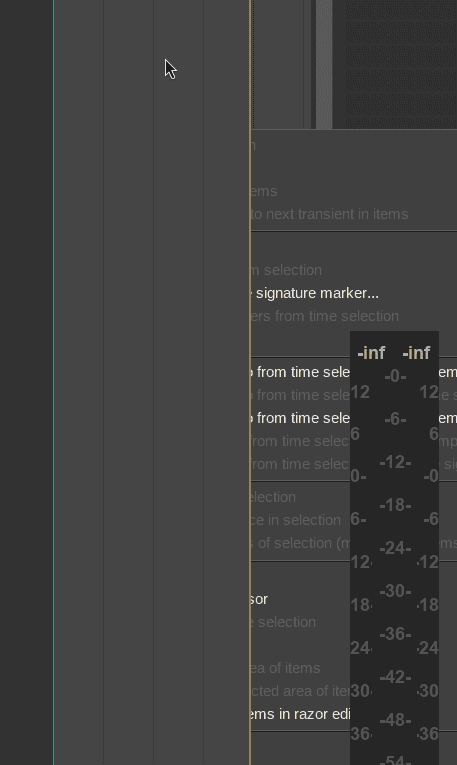
This is caused by the updatetoscreen drawing out of cycle and not taking the newly created popup into account.
On X11 this wasn't an issue, as the popups were created as As such the playhead could be rendered below it without any concerns
To avoid this, the updatetoscreen would have to take other windows into account.
Or maybe there whole internal logic of opening popups in REAPER should be changed.
X won't give it to you
Let's try adding a plugin to a new track. Specifically a 3rd party VST.
Segmentation fault: 11 (core dumped)
Ah, crashed again. The issue in this case is that there's already quite a bit of trickery going on in SWELL to even enable embedding plugin windows inside Reaper.
A large part of SWELl's GDK-specific logic is bridging these plugin windows inside REAPER's own windows.
For instance, here's BwArp, one plugin I've developed myself, inserted to a track:
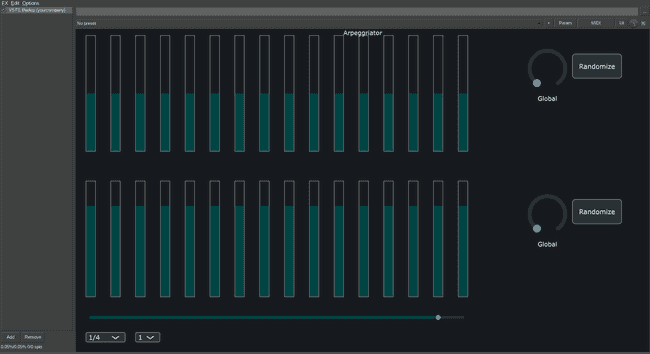
So REAPER also kind of acts like a window manager, or a separate desktop environment.
The problem is mimicking that behavior on Wayland. On X11 you have access to a global server which gives you information on any other processes windows. Whereas in Wayland (in being more secure) you can't exactly just point at a process ID and then start messing around with its various windows.
To enable similar behavior on Wayland, Reaper would have to act as a Wayland compositor in addition to everything else it does.
There's some interesting work related to this made by PreSonus, with the Studio One DAW already having Wayland support. But Linux support in audio plugins is already very limited, and only supporting Wayland plugins fragments the support even further.
In any case, having full XWayland-style bridging inside REAPER goes way beyond me and my small blog post.
But even though a production-ready solution is far away, there's still something we can experiment with.
Swell and CreateBridgeWindow
The bridging function is quite long, but here's a short summary on it:
- Create an empty X11 window
- Create a GDK window from that
- Assign a callback function (for resizing and other operations)
- Send the newly created bridge window forward
So what do do on Wayland? Instead of attempting to implement a full Wayland compositor inside someone else's APIs, we'll use some XWayland trickery instead.
This isn't nearly as bad of an option as it sounds since when dealing with DAW plugins means you've got hundreds of different pieces of software. The selection of Linux-compatible plugins isn't exactly huge to begin with, so there's no need to break compatibility with even the few ones which exist.
So let's implement the following:
- Create a "placeholder" GDK window which we feed onto existing SWELL functions
- This is equivalent to the real plugin bridge window being created on X11
- Also create a raw X11 window using XLib
- Use that XLib window as a parent for the plugin window
#ifdef GDK_WINDOWING_WAYLAND
if (GDK_IS_WAYLAND_DISPLAY (gdkdisp))
{
//x11 display should be retrieved from system, so that xwayland answers the call
disp = XOpenDisplay(NULL);
screen_num = DefaultScreen(disp);
w = XCreateWindow(disp,RootWindow(disp, screen_num),0,0,r->right-r->left,r->bottom-r->top,0,CopyFromParent, InputOutput, CopyFromParent, 0, NULL);
XMapWindow(disp, RootWindow(disp, screen_num));
XMapWindow(disp, w);
XFlush(disp);
GdkWindowAttr attr={0,};
attr.x = r->left;
attr.y = r->top;
attr.width = r->right-r->left;
attr.height = r->bottom-r->top;
attr.wclass = GDK_INPUT_OUTPUT;
const char *appname = g_swell_appname;
attr.wmclass_name = (gchar*)appname;
attr.wmclass_class = (gchar*)appname;
attr.window_type = GDK_WINDOW_CHILD;
gdkw = gdk_window_new(ospar, &attr, 0);
}Okay, let's try again.
Now we do get:
- A blank GDK window (Wayland)
- A floating plugin window (X11)
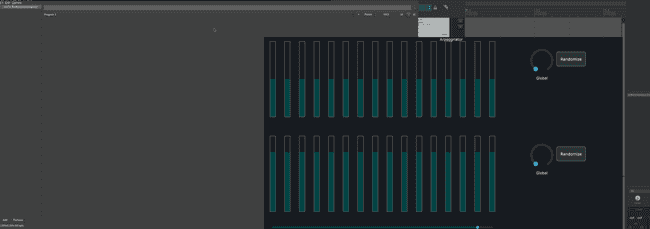
The floating plugin window is controlled as any other X11 application on Wayland, through XWayland.
Just to verify, here's what swaymsg outputs:
#1: root "root"
#2147483647: output "__i3"
#2147483646: workspace "__i3_scratch"
#3: output "X11-1"
#9: workspace "1:web"
#30: con "(null)"
#14: con "eliaswuoti@evo:~/reaper_wayland_test/REAPER_7.22" (xdg_shell, pid: 407670, app_id: "xfce4-terminal")
#31: con "eliaswuoti@evo:~" (xdg_shell, pid: 407670, app_id: "xfce4-terminal")
#22: con "[unsaved project] - REAPER v7.22 (xdg_shell, pid: 767280, app_id: "reaper")
#29: floating_con "(null)" (xwayland, pid: 767280, X11 window: 0x800001)
#28: floating_con "FX: Track 1" (xdg_shell, pid: 767280, app_id: "reaper")In the output you can see that both the main window and REAPER are running as a Wayland windows, while the BwArp window runs as an XWayland window.
Linking X and Wayland windows
This is pretty much the biggest issue within this whole blog post. Since the X window and Wayland window are managed completely independently, the user experience borders on unusable. Reaper's effects window is useless now that the plugin is not embedded inside it.
With this in mind the previous issues with popup windows and mouse coordinates aren't so bad anymore.
Conclusions
Here's a combined list of all the issues to be resolved. Some of them are major architectural actions, some of them are related to the environment REAPER is executed in, and some of them are just plain bugs:
- 3rd party plugins (VST) can't be bridged when they run
- Unless REAPER would run its own X server and handle bridging
- Popup windows and dialogs are opened outside of the main window
- GDK and REAPER's own scaling overlap
- Awful performance when running with both enabled
- Mouse events coordinates are not always sent correctly
- Depends on the scaling used
- Screen updates need additional workarounds on Wayland
- These in turn cause problems with existing rendering of dialogs
All in all, I'm not sure how ready Reaper (or any other DAW) on Linux is to run on Wayland. The biggest issue is that bridging X windows inside a Wayland window would require implementing a tool similar to XWayland but inside the DAW. Otherwise the DAW would have to rely on using X functions and very hacky overlaying of X and Wayland windows.
Lastly, my fork of WDL/SWELL is available here.